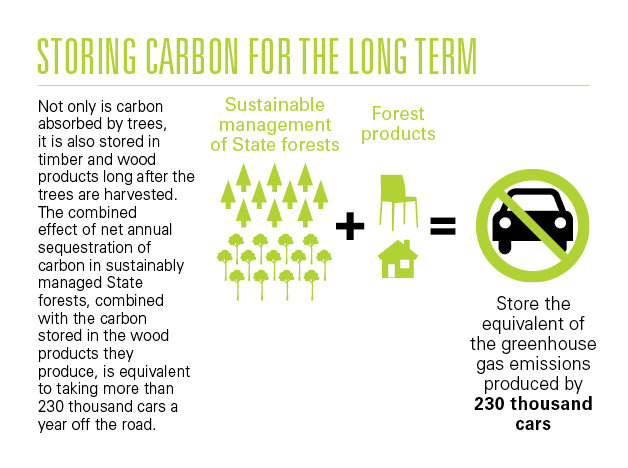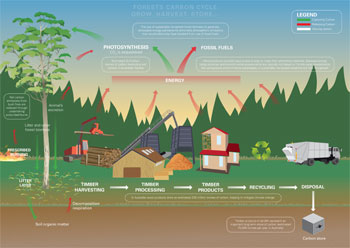Forestry and climate change
Many people know that growing trees absorb carbon dioxide but did you know the trees continue to store carbon even when they are turned into house frames, floorboards or furniture? Wood also has a much smaller carbon footprint than popular building materials such as steel, aluminium and concrete. That’s why responsibly-sourced wood can play a big part in helping tackle climate change.
In fact, the Intergovernmental Panel on Climate Change recognises that sustainably managed production forests that maintain carbon in growing trees while producing an annual yield of timber deliver a large, sustained climate change mitigation benefit.
Australian not-for-profit organisation Planet Ark has partnered with Forest and Wood Products Australia to promote the use of responsibly-sourced wood as a building material as a way to tackle climate change. You can find out more at makeitwood.org
Trees, timber and carbon storage
Growing trees absorb carbon dioxide from the atmosphere and store the carbon so efficiently that approximately half the dry weight of a tree is carbon.
While a forest is growing, it is actively removing carbon dioxide from the atmosphere and storing it in the form of wood. A forest left undisturbed will continue to store carbon for many hundreds of years, although the rate of storage will decline as the forest ages.
The beauty of sustainably managing forests that produce timber is that carbon remains stored in the wood products produced from the forest for many years, even while a new forest is being grown.
State forests are harvested sustainably and therefore play an important role in capturing and storing carbon, not just in standing trees but also in the timber and wood products they produce. Research has found that the carbon sequestered in sustainably managed State forests combined with the carbon stored in the wood products they produce is the equivalent to taking 230,000 cars off the road each year.

More than four million tonnes of carbon are stored (sequestered) in our plantations and native forests. In addition, two thirds of Australia’s total greenhouse gas emissions are stored in timber products such as tables, chairs and house frames. Even timber in landfill is still storing carbon, equivalent to more than 90 per cent of Australia’s greenhouse gas emissions.
The benefit of turning forest timber into products is that if trees are left to decompose in the forest, the carbon is returned to the atmosphere. That is why choosing certified sustainable timber products makes sense; no other product is as beneficial to the environment. Choosing sustainably sourced timber also reduces reliance on more carbon intensive alternatives such as concrete or steel.
NSW State forests are certified sustainable so when you source wood from a State forest, you know that the forest is being managed responsibly and another tree is already growing in its place, capturing carbon and having a positive impact on climate change.
The estimated volume of CO2 sequestered in NSW State forests and stored long-term in harvested products is calculated and updated annually and published in in our Sustainability Report.
Carbon accounting and trading
A carbon credit is a certificate stating how much carbon has been stored and then sold to a company wanting to offset their greenhouse gas emissions. One carbon credit is equal to one tonne reduction/absorption of carbon dioxide.
In Australia the only type of forest that is currently eligible for carbon trading is defined as ‘reforestation’. This is land that had previously been cleared but now converted back to tree production.
About 10 per cent of our plantations qualify for carbon trading. In 2005, Forestry Corporation became the first forest organisation worldwide to trade forest-based carbon credits within a registered trading scheme.




